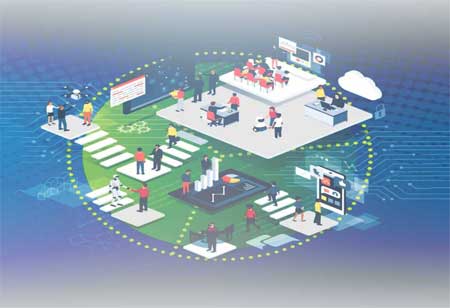THANK YOU FOR SUBSCRIBING
Extended Reality: Transforming Software Development
Extended Reality (XR) represents a transformative advancement within the realm of human-computer interaction,

By
Apac CIOOutlook | Tuesday, October 31, 2023
Stay ahead of the industry with exclusive feature stories on the top companies, expert insights and the latest news delivered straight to your inbox. Subscribe today.
The impact of Extended Reality on software applications, highlighting the emergence of virtual and augmented reality technologies in shaping digital experiences.
FREMONT, CA: Extended Reality (XR) represents a transformative advancement within the realm of human-computer interaction, embracing Virtual Reality (VR), Augmented Reality (AR), and Mixed Reality (MR). This groundbreaking integration serves as a conduit between the digital and physical domains, yielding immersive encounters that fundamentally redefine our perception and engagement with information. The software applications of XR have engendered significant metamorphoses across diverse sectors, including but not limited to gaming, education, healthcare, and industrial training.
Extended Reality (XR), a multifaceted realm encompassing Virtual Reality (VR), Augmented Reality (AR), and Mixed Reality (MR), represents a dynamic and transformative domain of human-computer interaction. Each facet within XR offers a unique approach to the augmentation and manipulation of our perceptual environment.
Virtual Reality (VR):
Virtual Reality engenders an immersive experience by transporting users into a simulated environment meticulously crafted by computational systems. This simulated realm is presented through the employment of specialised apparatus, notably VR headsets, allowing users to engage with the artificial setting as if it were a tangible reality. VR technology engenders an unparalleled level of immersion and escapism, enabling users to explore and interact with simulated scenarios that may range from fantastical landscapes to professional training simulations.
Augmented Reality (AR)
Augmented Reality, in stark contrast to VR, does not replace the tangible world but rather enhances a perception of it by superimposing digital content onto our real-world surroundings. This augmentation may encompass the provision of supplementary information or the integration of interactive elements into our physical environment. AR is commonly experienced through devices such as smartphones or AR glasses, which seamlessly combine the digital and physical realms. In doing so, AR redefines how we access information and engage with our surroundings, bridging the divide between the digital and the physical.
Mixed Reality (MR)
Mixed Reality, as the most intricate facet of XR, amalgamates elements of both VR and AR, facilitating the coexistence and interaction of digital and physical objects in real time. MR technologies, typified by devices like Microsoft's HoloLens, conjure a profoundly immersive and interactive domain where digital and tangible entities intermingle seamlessly. Users, equipped with MR headsets, are afforded the unique opportunity to experience an environment where the boundaries between the real and the virtual blur, yielding an enriched sensory experience that transcends the confines of traditional reality.
The Influence of Extended Reality (XR) Across Diverse Sectors
Gaming: Extended Reality (XR) has precipitated a profound transformation within the gaming industry, presenting an unparalleled level of immersion and interactivity. Exemplified by games such as Pokémon GO (AR) and Beat Saber (VR), XR has unequivocally showcased its capacity to redefine the gaming experience.
Education: Extended Reality (XR) has emerged as a catalyst in elevating the quality of educational experiences by imbuing them with interactivity and engagement. It empowers students to embark on immersive journeys through historical events in VR or delve into the intricacies of biological sciences by dissecting virtual organisms in AR.
Healthcare: The influence of Extended Reality (XR) is becoming increasingly pronounced in the realm of healthcare, contributing significantly to medical training, surgical planning, and therapeutic interventions. Surgeons can now engage in the practice of intricate surgical procedures within a risk-free virtual environment, a development that augments their skills and also contributes to a reduction in medical errors.
Tools and Platforms for Extended Reality (XR) Development
Unity3D: Unity3D stands as a preeminent game development engine with extensive applications in the realm of Extended Reality (XR). It offers support for both Virtual Reality (VR) and Augmented Reality (AR) platforms, rendering it the preferred choice for discerning developers.
Unreal Engine: The Unreal Engine, characterised by its formidable reputation for high-fidelity graphics and a robust toolkit, serves as another indispensable platform for XR development.
ARKit and ARCore: ARKit, catering to iOS, and ARCore, designed for Android, comprise indispensable toolkits for AR application development. These frameworks form the bedrock upon which developers construct captivating Augmented Reality experiences.
Future Trends and Considerations
As Extended Reality (XR) technology continually advances, we anticipate a trajectory that includes enhancements in hardware capabilities, more intuitive user interfaces, and widespread integration across various industries. Nevertheless, challenges in the domain persist, necessitating ongoing attention, including ensuring user safety, addressing privacy concerns, and achieving seamless integration with the real world.
Extended Reality (XR) is fundamentally redefining the world by seamlessly amalgamating the tangible and the virtual, a synergy that was once relegated to the realms of imagination. It is catalyzing profound shifts in the domains of entertainment, education, healthcare, and information consumption. XR represents an extraordinary technological frontier, heralding a future filled with promise and innovation.
For developers, wholeheartedly embracing XR equates to embracing the vanguard of technological progress. This entails the opportunity to conceive and manifest experiences that transcend conventional limitations, paving the way for a world where the demarcation between reality and the digital domain becomes increasingly indistinct.





